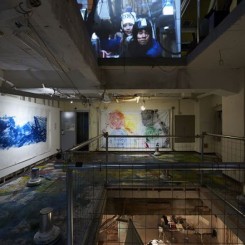This piece is included in Ran Dian’s print magazine, issue 5 (Spring 2017)
“Has the decision to host the Olympics not yet been made? Why is it that we dare not do such a thing?” —Deng Xiaoping, 1990
Can we still remember the time when Beijing was bidding for the Olympics in 2000, when the grass in the Xidan area was sprayed green? The new Maquanying and Fourth Ring subway lines had opened, and construction had just begun on the fifth ring road; from 1998 to 2007, Beijing’s investment in cleaning up environmental pollution amounted to 12 billion US dollars. The benefits of such an effort, however, do not extend into the present day, when pollution by 2.5 particulate matter persists in the city.
“Having built sports facilities like this [the National Olympics Sports Center], if we don’t end up hosting the Olympics, it would be half wasted.” (Deng Xiaoping) The rebuilding of the National Sports Center was not only a practical measure taken to boost athletes’ morale, it also meant the transformation of a popular sports event into a political event in which the nation’s will was unconditionally implemented, and the violent threat of authority widely felt.
Similarly, in Tokyo, harnessing the momentum of the 2020 Tokyo Olympics combined with the announcement of “anti-earthquake procedures” after Fukushima’s 3.11 earthquake, the government issued and enforced a series of urban redevelopment projects. In addition to Shinjuku Station, Shibuya Station, and Shibuya’s PARCO department store, even the historical and trendy Harajuku Station is undergoing restoration. Correspondingly, Kabukichō is pushing forward reconstruction plans for the entire district.
Faced with such changing landscapes, the Tokyo art collective Chim↑Pom asks: why is it that we prioritize the so-called “Olympics”? Locals (including Fukushima locals) have expressed concern that, since Tokyo’s urgent building projects are causing a shortage in construction workers, reconstruction after the 3.11 disaster has come to a standstill. Furthermore, the Japanese Government has been calling for international public opinion to rethink the meaning of the Olympics, calling it “The Recovery Olympics”, and connecting it back to the 1964 Tokyo Olympics. After all, it was precisely those Olympics in ’64 that helped Tokyo rise up from the ashes of post-war ruin; aided by the Olympian vision, Tokyo gradually developed into an international metropolitan city, from infrastructure-building to the renewal of its zeitgeist. While the will of the nation can only be expressed by competition with other countries, it is also constrained by all kinds of internal tension, which originates from efforts that accord the nation with fixed historical forms.
But what is recovery? What is urban revitalization?
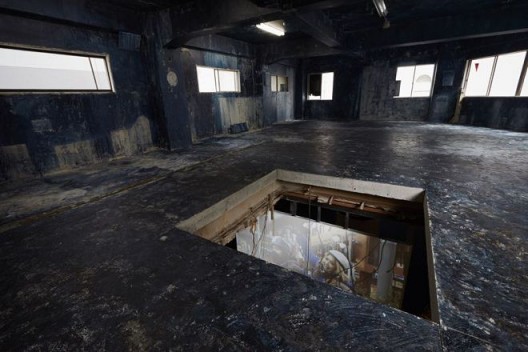
Chim↑Pom,《蓝图绘制版本2》,2016(版权:Chim↑Pom;鸣谢:艺术家和东京MUJINTO Production;摄影:KENJI MORITA)/ Chim↑Pom, “Drawing a blueprint version 2”, 2016 (© Chim↑Pom; courtesy of the artist and MUJINTO Production; Tokyo, photo by KENJI MORITA)
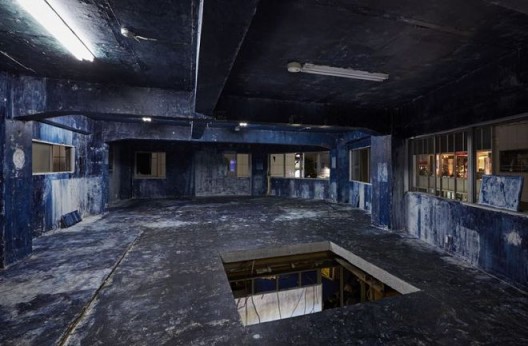
Chim↑Pom,《蓝图绘制版本2》,2016(版权:Chim↑Pom;鸣谢:艺术家和东京MUJINTO Production;摄影:KENJI MORITA)/ Chim↑Pom, “Drawing a blueprint version 2”, 2016 (© Chim↑Pom; courtesy of the artist and MUJINTO Production; Tokyo, photo by KENJI MORITA)
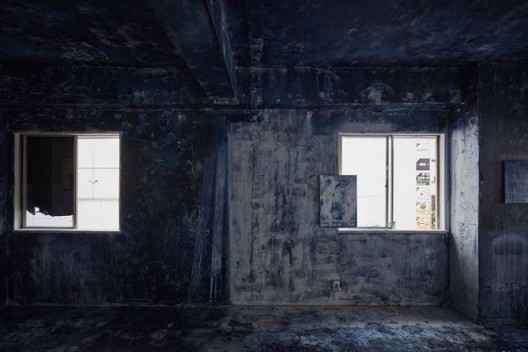
Chim↑Pom,《蓝图绘制版本2》,2016(版权:Chim↑Pom;鸣谢:艺术家和东京MUJINTO Production;摄影:KENJI MORITA)/ Chim↑Pom, “Drawing a blueprint version 2”, 2016 (© Chim↑Pom; courtesy of the artist and MUJINTO Production; Tokyo, photo by KENJI MORITA)
Using scraps to reconstruct the future?
Chim↑Pom’s new project “So see you again tomorrow, too?” is located in the Kabukichō Promotion Association Building, which, once a part of the Commercial Street Revitalization Union project in 1964, cost 15 million Japanese Yen to complete. 52 years later, as part of the 2020 Tokyo Olympics “Revitalization Project”, this building will be demolished in October. Living in a constantly fluctuating urban landscape, the Japanese have come to accept the proposition posed by these buildings and their fate. In Chim↑Pom’s opinion, historically speaking, Japanese people have acquired an aptitude for adopting a “Scrap and Build” logic and method through their many confrontations with catastrophe. But does the future of the 21st century necessarily entail the re-deployment of 20th century vision? “Using “Scrap and Build” as the theme of the exhibition, we will create a kind of experience that questions the ‘method of making blue-prints’.”
Works made using cyanotypes can be found throughout the building. In addition to being used in photography and the reproduction of architectural drawings, cyanotypes (or “blueprints”) can mean hope or new prospects when referred to in literature. Interested in this intersection between craft and meaning, Chim↑Pom created “Drawing a Blueprint Version 2″ on the fourth floor using cyanotypes—a technique gradually becoming obsolete in 21st century architectural design—to render a 20th century urban landscape that is slowly disappearing in the 21st century. What kind of sentiment does this combination conjure up: revitalization, progress, or regret? Likewise, in “Drawing Mirai”, a work on the second floor, Chim↑Pom uses cyanotypes to trace the outline of a sex worker. Calling herself “Mirai”, this 18-year old appears in Kabukichō, a district characterized by the sex industry, marginal groups, and entertainment culture, as well as hipster styles. Like any girl from Ichibangai Street, Mirai is a feature of this dazzlingly grotesque area—it is precisely owing to the lives that enliven these streets that Kabukichō can be said to bear witness to diverse ways of living, multifarious world views, and an unforeseeable future.
For “Libido-Electricity Conversion Machine”, Chim↑Pom released small advertisements containing telephone numbers on multiple media platforms, disguising themselves as a telephone sex service. The idea is that the “sex drives” generated by this work can be converted into electricity, a substitute energy for coal, oil, and natural gases: when a customer’s call is received, this device would “connect with” desire—radio waves are converted into electrical power via the relay’s optical sensors in order to keep the work running. In Kabukichō’s Ichibangai Street flow countless desires. In Shinjuku Swan, a film directed by Sion Sono in 2015, a group of “talent agents” seek out girls on the streets, luring them into the porn industry: “We want them to be happy, then use them to make money” was their motto. In Kabukichō, it is suggested that there is the potential for a mutual exchange of happiness and capital. Whether on screen or in real-life, it is, as the movie trailer says, “a place to dream”.
Kabukichō’s urban planning chief Hideaki Ishikawa once said: “Tokyo is too big. To a certain extent, it is lacking in spirituality.” Taking a dislike to big cities, Ishikawa stressed the importance of consumption over urban expansion and production, emphasizing in particular the development of the entertainment industry. As the officer in charge of Tokyo’s “War Damage Restoration Plan”, Ishikawa came up with the notion of “people building the city” in the belief that civic thoughts and actions mold the city’s character. Therefore, the rebuilding of Kabukichō was structurally centered around the plaza—according to Western architectural theory, under a democratic government, the plaza is an urban space imbued with the functions of political debate, commercial exchange, and social interaction. Here, the activist work by Chim↑Pom seeks to place the “soul” of Kabukichō under a two-level construction: one puts “Scrap and Build” into action, drawing a “blue print”, while the other draws the ritualistic tone of Scrap and Build’s logic into debates surrounding public space.
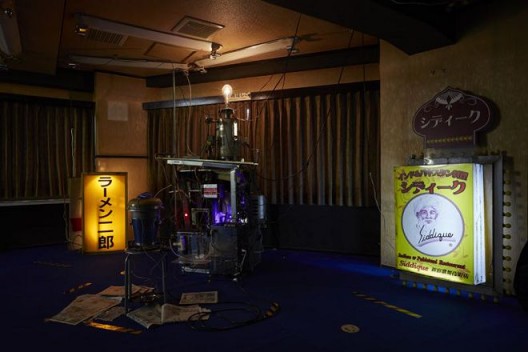
Chim↑Pom ,《力比多电力转换机“Erokitel”版本》(版权:Chim↑Pom,鸣谢:艺术家和东京MUJINTO Production,摄影:KENJI MORITA)/ Chim↑Pom, “Libido-Electricity Conversion Machine ‘Erokitel’ Fifth Version” (© Chim↑Pom; courtesy of the artist and MUJINTO Production, Tokyo; photo by KENJI MORITA)
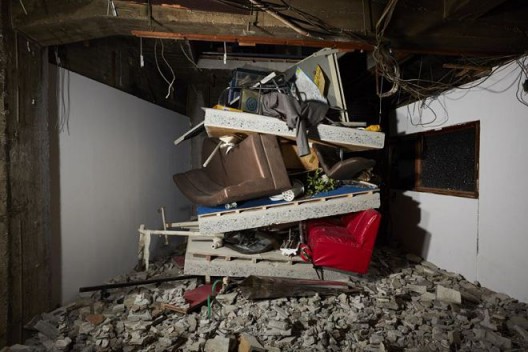
Chim↑Pom ,《Build-Burger》, 2016( 版权:Chim↑Pom;鸣谢:艺术家和东京MUJINTO Production;摄影:KENJI MORITA)/ Chim↑Pom, “Build-Burger”, 2016 (© Chim↑Pom; courtesy of the artist and MUJINTO Production, Tokyo; photo by KENJI MORITA)
Can society change art?
“(Can art change society?) We are not politicians. If politics can be said to change society, then art precisely proves that human nature cannot change. It would be better to reverse the question and ask, can society change art?”
Chim↑Pom[1],2016.6
Comprised of architectural waste, the installation work “Build-Burger” runs from the first floor to the fourth. “Offering”, a detailed work within the installation, invites the audience to pile up rocks taken from among the waste material. This gesture is inspired by the Japanese story On Sainokawara Dizou Wasan, in which children who died under the age of ten would be sent to a place like the riverbank of Sainokawara, there they would pile up stones to make a tower. If they got to layer one, they would see their father; layer two, their mother; at layer three, they would become Buddha. But in the process of building the stone tower, they are constantly obstructed by the Oni (devil), so that the tower is continuously destroyed. But with the bodhisattva Ksitigarbha’s help, these children are able to complete the tower so as to achieve samara. Going up the stairs, the entire second floor presents a domain of belief that maintains the balance of power: “Downtown Paradox” is like a robot vacuum’s Zen exercise—as a cleaning tool, it engages in the paradoxical labor of cleaning and polluting. Just like the paradoxical converter between “scrap” and “build”, the additive sum of normal cleaning procedures and acts of polluting—equated with creative labor—amount to zero in the structural system of conflicting logic; image creation and the erasure thereof co-exist in the same contradictory entity. Simultaneously, the seemingly unending cycle of karma seems to affirm that on the one hand, the labor of art activists exists constructively in political contexts; on the other hand, it also suggests that the ideological prospects that art activists hope to create are nothing more than an unrealizable future. Any realization of this goal is associated with time immemorial, yet art making is always grounded in the present—ambitious outlooks dissipate in the infinite deferment of time. As a result, any kind of ideologically-motivated art, though simultaneously possessing positivity and criticality, is bound to negate as well as terminate its own project every time it materializes.
On the third floor of the exhibition are “Super Rat” and “Black of Death”. In turning rats caught from the streets of Shinjuku into Pikachus, Chim↑Pom transforms action into spectacle, as flocks of crows circle the skies above Tokyo. Whenever people question what it is, exactly, that artistic actions can bring to society, there is already a presupposition that art, seen as useless, can only serve as the final celebratory act and express the status quo of aesthetics. Artists devoted to activism often attempt to change existing conditions at the social level, yet they cannot give up their identity as artists. As Boris Groys said, the “art” component in art activism is often seen as the main reason in which the activism itself fails at the level of practice and pragmatism in its immediate social and political impact. Therefore, the way to break free of this failure is to give up on art, just as, as long as social and political activism is not infected by the virus of art, it cannot fail. Now, problems concerning art activism found in contemporary art debates mainly deal with art’s function as political protest, the arena or medium for social activism. Art activists are not only interested in working with art’s system of critique and its mode of operations; conversely, they also hope to use art to change these modes of operation themselves.
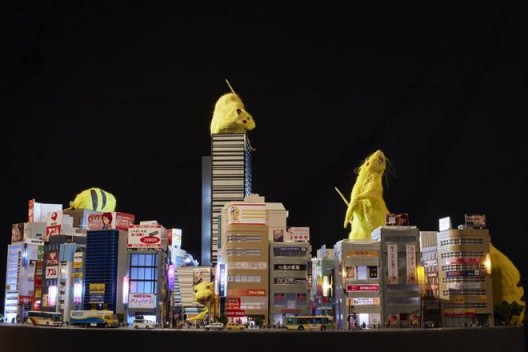
Chim↑Pom,《超级老鼠 – 实景模型新宿– 》,2016(版权:Chim↑Pom;鸣谢:艺术家和东京MUJINTO Production;摄影:KENJI MORITA)/ Chim↑Pom, “SUPER RAT –Diorama Shinjuku–”, 2016 (© Chim↑Pom; courtesy of the artist and MUJINTO Production, Tokyo; photo by KENJI MORITA)
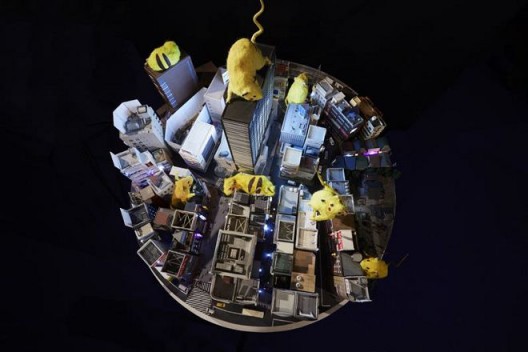
Chim↑Pom,《超级老鼠 – 实景模型新宿– 》,2016(版权:Chim↑Pom;鸣谢:艺术家和东京MUJINTO Production;摄影:KENJI MORITA)/ Chim↑Pom, “SUPER RAT –Diorama Shinjuku–”, 2016 (© Chim↑Pom; courtesy of the artist and MUJINTO Production, Tokyo; photo by KENJI MORITA)
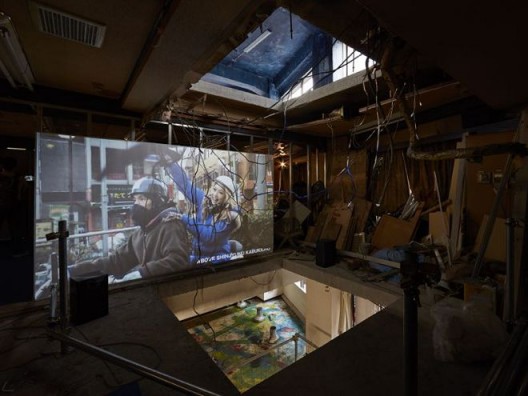
Chim↑Pom,《死亡的漆黑》,2008、2016(版权:Chim↑Pom;鸣谢:艺术家和东京MUJINTO Production;摄影:KENJI MORITA)/ Chim↑Pom, “Black Of Death”, 2008, 2016 (© Chim↑Pom; courtesy of the artist and MUJINTO Production, Tokyo; photo by KENJI MORITA)
As art activists, Chim↑Pom is responding to the day-to-day collapse of contemporary social conditions, attempting to replace social or non-governmental organizations based on different lines of reasoning. The difference is that they are not quick to abandon art or to try to make it “useful”. It is just as Simon Critchley writes in The Problem of Hegemony, “politics begins right here, locally, practically and specifically, around a concrete issue.” Looking at the “specific actions” of Chim↑Pom—using a jet to write the words “ピカッ(pika)”in the Hiroshima sky, symbolizing the explosion of atomic bombs; or adding an image of nuclear power-plant debris to the bottom-right corner of “Myth of Tomorrow”, a large-scale mural by Taro Okamoto located in Shibuya Station; or using VR equipment to reflect the desires projected by Fukushima’s indigenous people living under low radiation…etc.—these so-called actions should not have to be accomplished by running off to protest at some meeting of the G8; “You shouldn’t meet your enemy on their ground, but on your own, on the ground that you have made your own. Also, think of the money and time you save on travel!”
Using “ART is in the pARTY” as their “manifesto”, Chim↑Pom enlists live music, performance, and party-themed carnival, as well as the ceremony in which all the exhibited works will be completely destroyed by architecture specialists at the end of the exhibition (the exhibition itself will not actively be taken down—it will also be destroyed by the demolition), to create a new kind of encounter. Carnival gives “the world turned upside down” a legitimate existence. Although the subversive format of carnival is nothing but an ecstatic experience and does not entail a substantial subversive effect, it is in such a hyper-frenzied state that real subversion emerges—according to Bakhtin’s theory of the Carnivalesque, it provides a real method for realizing collective thought. Subversion is not only a characteristic of the event itself; akin to the process of disintegration, it is a mode of living, a game in parallel to real life. The carnival is a kind of “realized utopia”. The ritualistic aspect of carnival is premised on the separation between the real and the fantastic: whereas real life is serious, the latter provides the tool for sacrilege and play. Entering the latter via the former, one could create on the basis of the real, a new real that is simultaneously indirect, simulated, and open, through the ability to general one’s own symbols and concepts.
Carnival is a holiday filled with laughter. The main visual impact of Chim↑Pom’s poster “So see you again tomorrow, too” is a muddy smile. It is as though when one feels the exhilaration of synesthesia and experiences the process of being resurrected from death, a charming smile flowers from the birth of a new world, whether it is heartfelt or bitter. Explaining the duality of laughter in carnivals, Bakhtin says, “carnivalistic laughter likewise is directed toward something higher—towards a shift of authorities and truths, a shift of world orders. Laughter embraces both poles of language, it deals with the very process of change, with crisis itself. Combined in the act of carnival laughter are death and rebirth, negation (a smirk) and affirmation (rejoicing laughter). This is a profoundly universal laughter, a laughter that contains a whole outlook on the world. Such is the specific quality of ambivalent carnival laughter.”
When the exhibition is completely destroyed, Chim↑Pom will collect the fragmented pieces of artworks that will have shared the same fate as the buildings and reconstruct them. From the neon letters taken from the to-be-demolished PARCO department store, we will keep the letters “C” and “P” that represent Chim↑Pom. Chim↑Pom will present an exhibition comprised of these fragments in GARTER art space as a follow-up to “So see you again tomorrow, too?” The phrase “So see you again tomorrow, too?” is taken from the closing line of television host Kazuyoshi Morita’s variety show “It’s OK to Laugh!”, a long-running show that lasted 32 years. In the production of the final episode, even though it was clear that there would be no more chances to “see you again”, Morita still ended with “So see you again tomorrow, too?” As “the end” will surely come, Chim↑Pom asks the audience of “tomorrow” for the scrap and rebuild of the future.
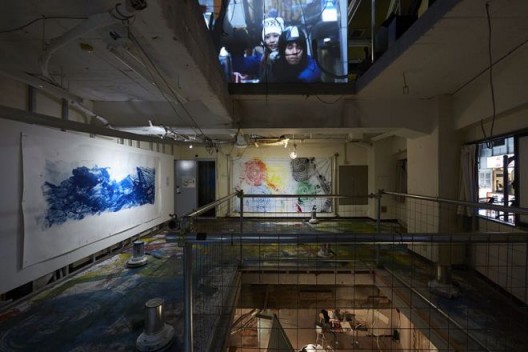
Chim↑Pom,《人们造了一座城》(左)、《五环》(中)和《都市悖论》(地板装置),2016(版权:Chim↑Pom;鸣谢:艺术家和东京MUJINTO Production)/ Chim↑Pom, “The People Make the City” (left), “Five Rings” (center), and “Downtown Paradox” (floor installation), 2016 (© Chim↑Pom; courtesy of the artist and MUJINTO Production, Tokyo)
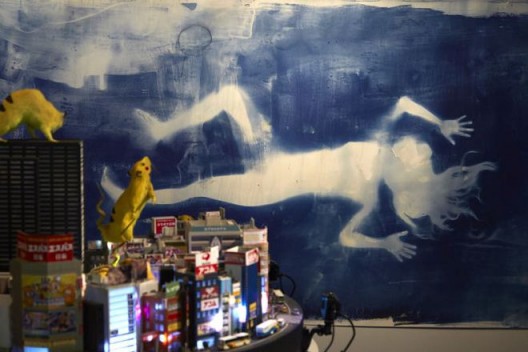
Chim↑Pom,《绘制未来》,2016 (版权:Chim↑Pom;鸣谢:艺术家和东京MUJINTO Production;摄影:KENJI MORITA)/ Chim↑Pom, “Drawing Mirai”, 2016 (© Chim↑Pom; courtesy of the artist and MUJINTO Production, Tokyo; photo by KENJI MORITA)
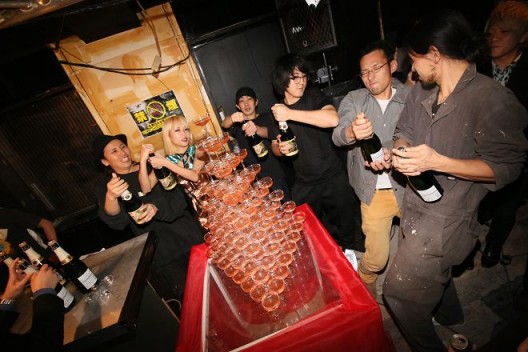
Chim↑Pom的成员在开幕派对上祝酒(摄影:YUKI MAEDA) / Chim↑Pom members make a toast at the opening party (photo by YUKI MAEDA)
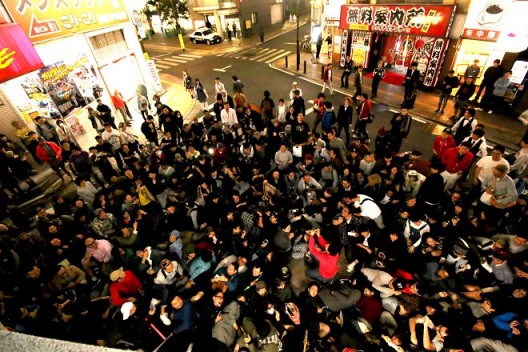
聚集在实验剧团Akumanoshirushi的人群(摄影:YUKI MAEDA) / Crowd gathering around experimental theater group Akumanoshirushi (photo by YUKI MAEDA)
[1] “在艺术的上空炸一下“,《知日·现代霓虹艺术力》,总35期,2016.6



